One of the four basic math operations is division. The other three are adding, subtracting, and multiplying. In simple terms, the division is breaking up a large group into smaller groups so that each group has the same number of things. In math, it is a way to make sure that everyone gets the same amount of something. Let’s learn more about the math operation of division in this article.
What is Division?
One of the most basic ways to do math is to divide a larger number into smaller groups with the same number of things in each group. For example, if 30 students need to be split into 5 groups for a sports event, how many groups will be made in total? Using division, it’s easy to solve these kinds of problems. We need to divide 30 by 5 in this case. 30 ÷ 5 = 6, which is the answer. So, there will be 6 groups, each with 5 students. You can check that this number is correct by multiplying it by 6 and 5, which gives you the original number, 30.
Division Methods :
- Division as Equal Distribution
The division is the process of equal sharing or Dividing into Equal Groups.
We took an example of 12 pencils and divided them into four groups.
So we divided the pencils into four groups of three pencils each, as illustrated in the diagram below.
So if we divide 12 in 4 groups, each will have 3 pencils We can Also Divide 12 into 3 groups and then each group will have 4 pencils.
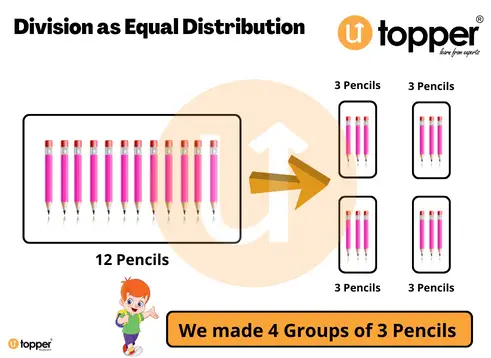
- Division by Repeated Subtraction
The process of dividing is to subtract over and over again. It is the opposite of the operation of multiplying. It is the act of putting people into groups of the same size. When dividing numbers, we break a larger number into smaller numbers so that multiplying the smaller numbers adds up to the original larger number. For instance, We have taken an example of 12 apples and On Subtracting 3 Apples Repeatedly 4 Times we get our Answer.
So 12 Apples – 3 Apples = 9 Apples ( First Time Subtraction )
9 Apples – 3 Apples = 6 Apples (Second Time Subtraction )
6 Apples – 3 Apples = 3 Apples ( Third Time Subtraction )
3 Apples – 3 Apples = 0 ( Fourth Time Subtraction )
So We Subtracted 3 Apples, 4 times , So on Dividing 12 Apples ÷ 3 Apples = 4
The Below Diagram Explain the Concept perfectly:
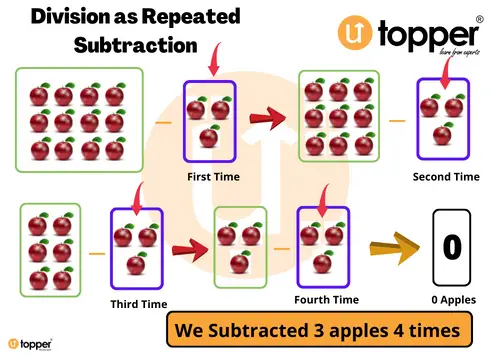
Division Symbols
The division is represented by a mathematical symbol consisting of a small horizontal line with a dot above and below it. The division of two numbers is represented by two basic division symbols. They are both and. For instance, 4 ÷ 2 Equals 2, and 4/2 = 2.
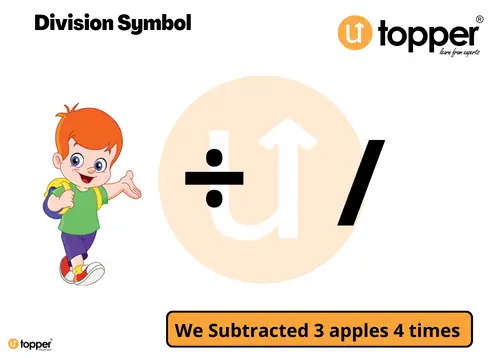
Parts of Division
The names of the phrases connected with the division process are referred to as division parts. Dividend, divisor, quotient, and remainder are the four parts of the division. Let’s look at an example of the division below and figure out what these four elements of division mean.
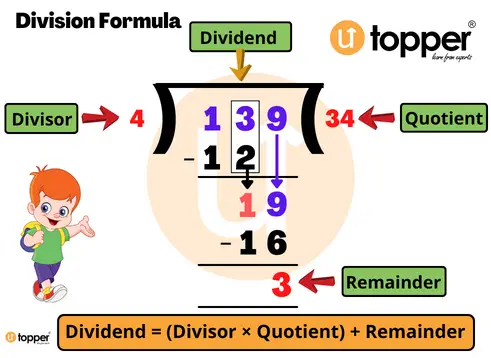
Dividend = ( Divisior × Quotient ) + Remainder
139 = ( 4 × 34 ) + 3
Here, when we divide 139 by 4, we get the values of a divisor, dividend, quotient, and remainder. Look at the table below to understand the meaning of these terms.
| Terms | Descriptions | Values |
| Dividend | The number that is to be divided | 139 |
| Divisor | The number of equal groups that are to be made, or the number by which we divide the dividend | 4 |
| Quotient | The value/answer obtained after performing the division | 34 |
| Remainder | The remaining or left out the value that is not a part of any group | 3 |
“Dividend = Divisor Quotient + Remainder” is written in the image above. This equation fulfills the above values, but will it satisfy dividend, divisor, quotient, and remainder values in all divisions? Let us investigate.
Division Algorithm
The division algorithm is an equation that connects all four parts of the division. In every division fact, the product of the divisor and the quotient added to the remainder is always equal to the dividend amount. Thus, the universal division formula is:
Dividend = (Divisor Quotient) + Remainder. This is referred to as the division algorithm.
The above formula allows us to check the values of the quotient and remainder produced after division. In the preceding equation, we can substitute the values of the quotient, remainder, and divisor to see if the outcome is the same as the dividend. If we get the dividend, it means we followed the division stages correctly. If not, it indicates that there is an issue in our computations that we must correct.
Let’s look at an example to check if it meets the above formula and Satisfies the division procedure. 139 divided by 4 equals When we divide 139 by 4, we get 34 as the quotient and 3 as the remainder.
Dividend = (Quotient Divisor) + Remainder
139 = (4 × 34) + 3
139 = 136 + 3
139 = 139
Hence verified.
How to do Division?
One-digit division can be done using multiplication tables. For example, to solve 35÷ 7, we just need to see what we need to multiply by 7 to get 35 as the answer. Clearly, 7 × 5 = 35, therefore 35÷ 7 = 5.
When it comes to the division of numbers with greater numbers, then we can use the long division method. Let us take the example of 139 divided by 4 to understand it. Follow the steps below to learn how to do division:
Step 1: Draw the division symbol ⟌ and write divisor (4) on its left side and dividend (139) enclosed under this symbol.
Step 2: Take the first digit of the dividend from the left (1). Check if this digit is greater than or equal to the divisor. [If the first digit of the dividend is less than the divisor, then we consider the first two digits of the dividend]
Step 3: Then divide it by the divisor and write the answer on top as the quotient. Here, the quotient of 13 ÷ 4 is 3.
Step 4: Subtract the product of the divisor and the digit written in the quotient (4 × 3) from the first digit of the dividend and write the difference below. Here, the difference is 13 – 12 = 1.
Step 5: Bring down the next digit of the dividend (if present). The next digit in the dividend is 9.
Step 6: Repeat the same process until you get the remainder, less than the divisor.
Look at the image given below showing the above steps of division.

Division with Remainders
It is not always required to have a remainder equal 0. The remainder is not zero if the dividend is not a multiple of the divisor. When dividing one integer by another and obtaining a non-zero remainder, we speak about a division with remainders.
Let us take an example if Nancy wants to Distribute 14 Chocolates equally among her 3 friends. How many chocolates will each of her friend get?
After Dividing 14 with 3 we get 2 as a Remainder.
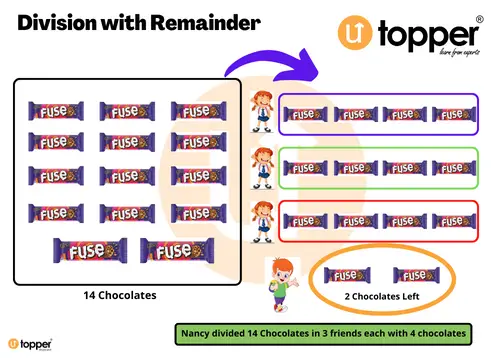
Properties of Division
- Dividing a Number by 1
Any Number Is Divided by 1 gives the number itself as the quotient.
Example: If we divide 10 ÷ 1 = 10
- Dividing a Number by itself
If we divide a number by itself, we will always get 1 as the answer.
Example: If we divide 10 ÷ 10 = 1
- Dividing 0 by any number
Zero Divided by any number ( except 0 ) gives 0
Example : 0 ÷ 4 = 0, 0 ÷ 9 = 0, 0 ÷ 54 = 0
- Dividing a Number by itself
The value of a number divided by 0 is not defined, i.e. n/0 = not defined, where n is any number.
- Dividing by 10
If a number is divided by 10, the digit in the one’s place is always the remainder and the digits on the left are the quotient.
- Dividing by 100
If a number is divided by 100, the number created by the one’s place and tens place digits is always the leftover, while the remaining digits on the left are the quotient.
Division Examples :
Example 1: 42 pencils were distributed among 16 children. How many pencils did each child get? How many pencils were left over?
Solution: Number of pencils with 16 children = 42
Number of pencils with one child = 42 ÷ 16
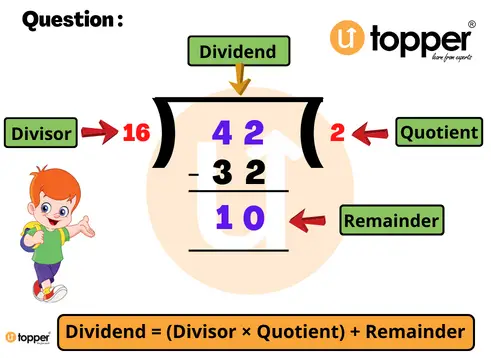
Example 2: Divide 95 by 6 by Long Division Method and Verify it.
Solution :
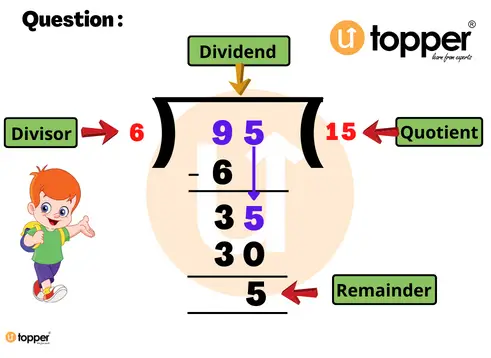
To check division, we will put the values in the formula, Dividend = (Divisor × Quotient) + Remainder.
So, 95 = 6 × 15 + 5 = 95. Hence, verified.
Example 3: Poonam has paid $ 243 for 3 Books. How much did she pay for each book?
Solution :
Cost of 3 Books = $ 243
Cost of 1 Book = $ 243 ÷ 3
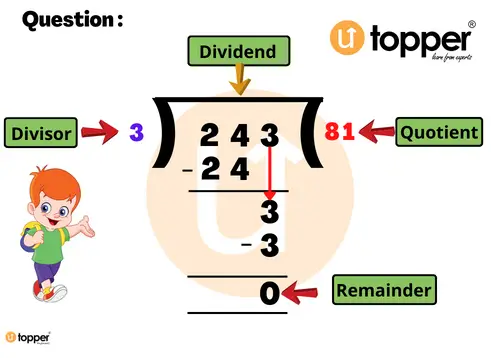
Poonam Paid $ 81 for each Book
FAQs ( Frequently Asked Questions ) on Division
Q.1 What is Division in Maths?
Ans – There are four fundamental arithmetic operations in mathematics: addition, subtraction, multiplication, and division. The division is an important operation that we utilize frequently in our daily lives, along with the other three operations listed above. Division involves creating parallel subsets from a larger whole. To demonstrate, subtract 5 from 25. In this case, the division fact is 25 ÷ 5 = 5.
Q.2 What are the Two Types of Division?
Ans – There are two distinct categories here: partitive and quotative models. When dividing a whole into a fixed set of parts, we utilize the partitive notation. By dividing 4 into 2 slots, for instance, we can determine how many objects will fit into each compartment. In order to divide a number into equal parts of a quotient, the quotative method of division is used. The number of possible spaces can be calculated, for instance, by dividing 4 by 2.
Q.3 What are the 4 types of division?
Ans – There are four important terms used in division. These are dividend, divisor, quotient, and remainder.
Q.4 What is the division formula?
Ans – Dividend ÷ Divisor = Quotient + Remainder is the formula that is used to compute the result of dividing two numbers. In this case, the number that is being divided is referred to as the dividend. The number that divides the other number (the dividend) into equal parts is referred to as the divisor.
Q.5 What are the Steps of the Division?
Ans – The steps to do division are listed below:
Step 1: Take the first digit of the dividend. Check if this digit is greater than or equal to the divisor.
Step 2: Then divide it by the divisor and write the answer on top.
Step 3: Subtract the result from the digit and write below.
Step 4: Again, repeat the same process.
Q.6 How to Divide Decimals?
Ans – Decimal division is just as simple as a division with whole numbers. The decimal can be converted to an integer by multiplying it by powers of 10. Then, standard division procedures can be applied. Using the same powers of 10 that you used earlier, divide your final solution by its component parts.
Q.7 What are the Rules of Multiplication and Division of Integers?
The rules for the multiplication and division of integers are given below:
Positive ÷ / × positive = positive
Negative ÷ / × negative = positive
Negative ÷ / × positive = negative
Positive ÷ / × negative = negative
Q.8 Why Division by Zero is Undefined?
Since zero cannot be divided by any other number, division by zero is undefined. This is due to the fact that multiplying any number by zero yields zero. Now, consider the opposite. The value of 1/0 will be infinite. Consequently, dividing by zero gives an indeterminate result for any number.

